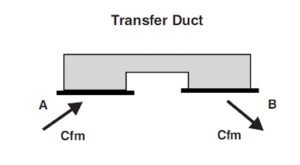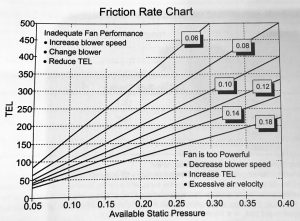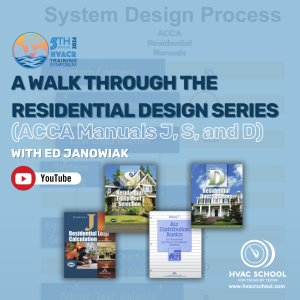BACK
 When Ducts Get Too Big
When Ducts Get Too Big
 Making Duct Systems Work
Making Duct Systems Work
 Under Pressure
Under Pressure
 What Airflow Goes Around HAS to Come Around
What Airflow Goes Around HAS to Come Around
 Does your Kitchen Exhaust Suck?
Does your Kitchen Exhaust Suck?
 Equivalent Length Merry-Go-Round
Equivalent Length Merry-Go-Round
 Manual D Speedsheet Walkthrough
Manual D Speedsheet Walkthrough
 Homeowner’s Guide to Sizing an AC System (and who is responsible when you’re uncomfortable)
Homeowner’s Guide to Sizing an AC System (and who is responsible when you’re uncomfortable)
 The Friction Rate Chart (and What it Means)
The Friction Rate Chart (and What it Means)
 Common Duct Design Mistakes w/ Jack Rise (Podcast)
Common Duct Design Mistakes w/ Jack Rise (Podcast)
 A Walk Through the Residential Design Series (ACCA Manuals J, S, and D)
A Walk Through the Residential Design Series (ACCA Manuals J, S, and D)
 ACCA Manuals in the Real World
ACCA Manuals in the Real World
#manual d
Tech Tips:

This tech tip recaps the livestream by the same name, featuring HVAC School contributors Matt Bruner and Adam Mufich, as well as special guests Russ King, Steve Rogers, and Tony Amadio. You can watch that live stream on our YouTube channel HERE. It was a beautiful day outside. The sun was shining, the birds were […]
Read more
This tech tip recaps the livestream by the same name, featuring HVAC School contributors Matt Bruner and Adam Mufich, as well as special guests Ed Janowiak and David Richardson. You can watch that live stream on our YouTube channel HERE. It’s one thing to install a piece of equipment, but it’s another thing entirely to […]
Read more
A few weeks ago, I was hired to consult on a multi-family new construction project. The building was already framed, and the ducts were roughed in. The owner of the building was concerned with the quality of the ductwork. He noticed that the HVAC company was not following the mechanical engineer's plans. This was my […]
Read more
Have you ever woken up early on a Saturday morning and thought to yourself, “I really wish I knew how to size transfer grilles and jumper ducts properly?” I know I have. Although come to think of it, I believe it was a Friday morning. Properly sizing transfer grilles is something I have been wanting […]
Read more
Have you ever been tasked with installing the exhaust duct for a kitchen hood? I have, and when doing so, I wondered how to size the duct run correctly. Since I had a basic understanding of how airflow works, I knew that there had to be a limit on the resistance the fan can handle; […]
Read more
I recently read a tech tip by Matt Bruner about using the Manual D process. In the article, he designed a duct system for a small job using a ducted mini-split. One thing I noticed about his design was that the supply and return duct velocity was fairly low compared to the arbitrary 900-feet-per-minute supply […]
Read more
Bryan recently released a podcast on rules of thumb and how they can really get us in a pickle with sizing ductwork. With that in mind, I thought this might be a good time to do a walkthrough of Manual D from start to finish on a project I just finished up. My good friend […]
Read more
This tech tip was a collaborative effort between Matt Bruner, Adam Mufich, Ed Janowiak, and Genry Garcia. Thank you to everybody who gave their input! The next time you come across a homeowner who wants a bigger HVAC system, or you simply want to set expectations for a customer, share this tech tip with them. […]
Read more
A lot of proper duct design comes down to an understanding of available static pressure and friction rate. We've covered this topic several times on this site and the podcast, but I wanted to focus on this ACCA chart specifically (shown above). If you want a deep dive, I highly recommend listening to my podcast […]
Read moreVideos:
Podcasts:

In this episode, Jack Rise talks about duct design regarding ACCA manual D, friction rate, face velocity, duct velocity, and what is ACTUALLY wrong with flex duct. Manual D causes a lot of confusion for technicians, and most techs have a limited understanding of it anyway. When determining a blower wheel for commercial ductwork, Jack […]
Read moreEvents:

NOTE: If you cannot view the recording, the video may still be processing. The maximum wait time is 24 hours. We apologize for the delay and appreciate your patience.
Read more
NOTE: If you cannot view the recording, the video may still be processing. The maximum wait time is 24 hours. We apologize for the delay and appreciate your patience.
Read more








